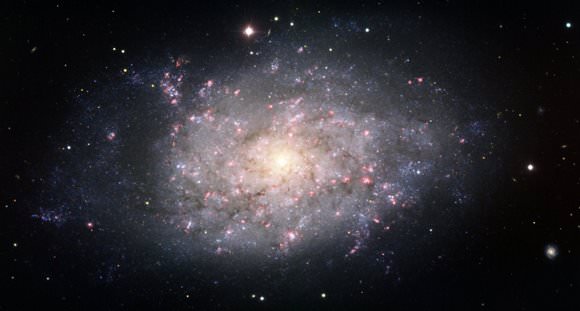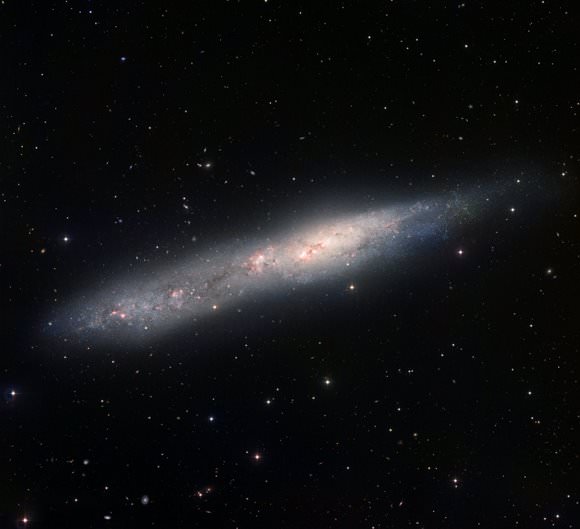[/caption]
As part of the International Year of Astronomy project, 100 Hours of Astronomy, the ambitious “Around the World in 80 Telescopes” event had a live webcast, going around the globe to some of the most advanced observatories on and off the planet. In celebration of this world tour of observatories, many of the telescopes are releasing wonderful, and previously unseen, astronomical images. Here are two observed by telescopes at the La Silla and Paranal observatories. Above is the irregular galaxy NGC 55, a galaxy that is about 70,000 light-years across, just a tad smaller than our own Milky Way, and below is NGC 7793, about half that size.
NGC 55 is a member of the prominent Sculptor group of galaxies in the southern constellation of Sculptor. By studying about 20 planetary nebulae in this image, a team of astronomers found that NGC 55 is located about 7.5 million light-years away. Planetary nebulae are the final blooming of Sun-like stars before their retirement as white dwarfs.
This striking image of NGC 55, obtained with the Wide Field Imager on the 2.2-metre MPG/ESO telescope at La Silla, is dusted with a flurry of reddish nebulae, created by young, hot massive stars. A large number of individual stars that can be counted within NGC 55.

The second image shows another galaxy belonging to the Sculptor group. This is NGC 7793, which has a chaotic spiral structure, unlike the class of grand-design spiral galaxies to which our Milky Way belongs. The image shows how difficult it is to identify any particular spiral arm in these chaotic structures, although it is possible to guess at a general rotating pattern. NGC 7793 is located slightly further away than NGC 55, about 12.5 million light-years from us.
NGC 7793 was observed with one of the workhorses of the ESO Paranal Observatory, the FORS instrument, attached to the Very Large Telescope.
Source: ESO


Hi Nancy,
can u confirm whether it NGC 77993 or NGC 7793?? There is a small confusion in the article!!
Thanks
@ Vino: The correct designation is NGC 7793. Easy rule for NGC objects-they number under 10,000 (objects are numbered from NGC 1 to NGC 7838).
Whoops, sorry about the typo — thanks for pointing that out and its been corrected. It is NGC 7793.
The Sculptor Group is one of the closest galaxy groups, allowing astronomers to view its’ members with unprecedented clarity. Other prominent members include NGC 253, NGC 300, NGC 247 as well as a number of dwarf galaxies. Though these galaxies are rather low in the Southern sky for NA and European observers, their large angular size make them appealing targets for astroimagers.